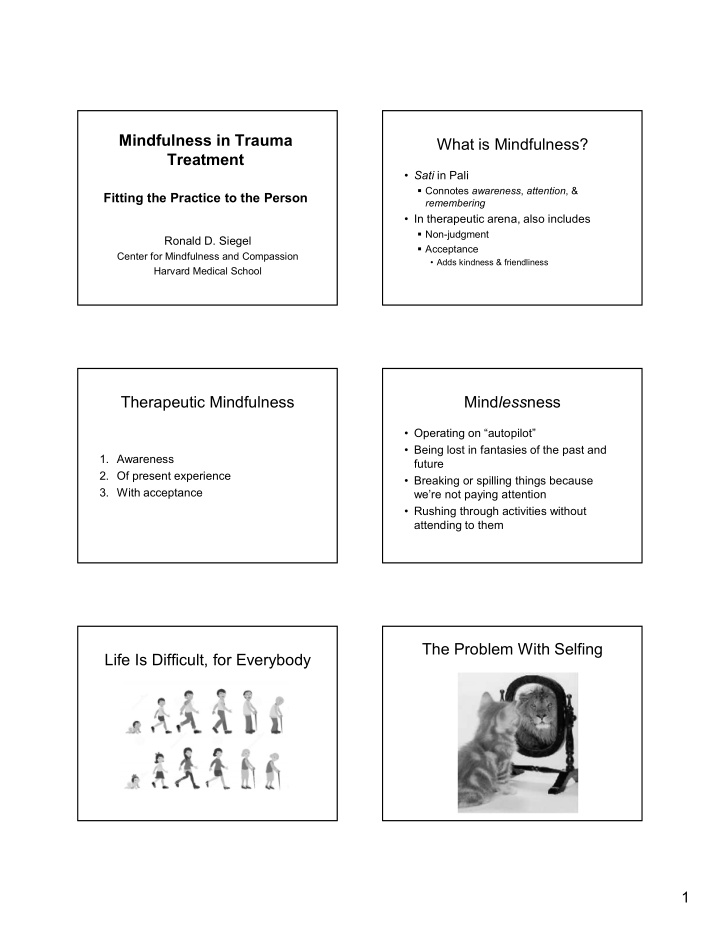



Mindfulness in Trauma What is Mindfulness? Treatment • Sati in Pali Connotes awareness , attention , & Fitting the Practice to the Person remembering • In therapeutic arena, also includes Non-judgment Ronald D. Siegel Acceptance Center for Mindfulness and Compassion • Adds kindness & friendliness Harvard Medical School Therapeutic Mindfulness Mind less ness • Operating on “autopilot” • Being lost in fantasies of the past and 1. Awareness future 2. Of present experience • Breaking or spilling things because 3. With acceptance we’re not paying attention • Rushing through activities without attending to them The Problem With Selfing Life Is Difficult, for Everybody 1
Mindfulness Can Help Us Mindfulness Practice is Not: • To see and accept things as they are • Having a “blank” mind • To loosen our preoccupation with “self” • Becoming emotionless • To experience the richness of the • Withdrawing from life moment • Seeking bliss • To become free to act skillfully • Escaping pain Breath Awareness The Roles of Mindfulness Implicit • Practicing Therapist • Mindfulness Informed Psychotherapy • Mindfulness Based Psychotherapy Explicit How It Works Fly 2
Overwhelmed? Intensity of Capacity to bear experience experience The Thinking Disease How Does Mindfulness Help? • Reinforces experiential approach • Review past pleasure and pain • Helps free us from believing in our thoughts • Reduces narcissistic orientation • Try to maximize future pleasure and • Connects us to the world beyond our avoid future pain personal pleasure and pain Decisions, Decisions 1. Which skills to emphasize? 2. Formal or informal practice? 3. Which objects of attention? 4. Religious or secular practices? 5. Narrative or experiencing mode? 6. Relative or absolute truth? 7. Turning toward safety or sharp points? 3
Focused Attention vs. Core Practice Skills Open Monitoring • Concentration (FA) 1. Concentration (focused attention) Choose an object and follow it closely 2. Mindfulness per se (open monitoring) • Mindfulness (OM) Attend to whatever 3. Acceptance and Compassion object rises to forefront of consciousness Acceptance Loving-kindness Practice • “Metta” practices May I be happy, peaceful, free from suffering May my loved ones be happy. . . May all beings be happy. . . Continuum of Practice Informal Practice Informal Mindfulness Practice Formal Meditation Practice Intensive Retreat Practice 4
Taillight Meditation Shower Meditation Formal Practice Intensive Retreat Practice (Results May Vary) • Data supports effects of formal meditation • Structural and functional brain changes. Resources at: meditationandpsychotherapy.org Objects of Attention Religious or Secular? Course • “Spiritual” practices • Feet touching ground Devotional and theistic • Sights and sounds of nature • Taste of food • Secular practices • Sound of bell Science grounded • Breath in belly • Mantra • Seek cultural consonance • Air at tip of nose Subtle 5
Narrative Mode Experiencing Mode • Psychodynamic • How is it felt in the body? Earlier, transference, other relationships • How does the mind respond? • Behavioral Grasping How learned, how reinforced Pushing away • Systemic Ignoring Maintained by family, community, culture Relative Truth Absolute Truth • Human story Success & Failure • Anicca Pleasure & Pain (impermanence) Longing • Dukkha Hurt (unsatisfactoriness) Anger • Anatta (no enduring, Envy separate self) Joy Pride Processing Trauma 1. Open to painful emotions Timing is Everything 2. Explore the facts of trauma 3. See it through lens of dependent origination 4. Develop compassion 6
Turning toward Safety I Turning toward Safety II • Inner focus • Outer or distal focus Mountain Meditation Walking Meditation Guided Imagery Listening Meditation Metta Practice Nature Meditation DBT techniques Eating Meditation Open eye practices Turning Toward the Sharp Different Strokes Points • Need for frequent adjustment of • Moving toward anything exercises unwanted or avoided • How is it experienced in • Elicit feedback about the experience the body? Both during and after practice Pain, fear, sadness, anger Unwanted images or • Titrate between Safety and Sharp memories Urges toward Points compulsive behaviors When Mindfulness of Inner Life Preservers Experience Can Be Harmful • When overwhelmed • Concentration Practices by traumatic memories Stepping out of the thought stream • When terrified of disintegration, loss • Eyes open, external of sense of self sensory focus • When suffering from Ground, trees, sky, psychosis wind, sounds 7
Decisions, Decisions 1. Which skills to emphasize? 2. Formal or informal practice? 3. Which objects of attention? 4. Religious or secular practices? 5. Narrative or experiencing mode? 6. Relative or absolute truth? To learn mindfulness practices, visit: 7. Turning toward safety or sharp points? www.mindfulness-solution.com 8
Recommend
More recommend